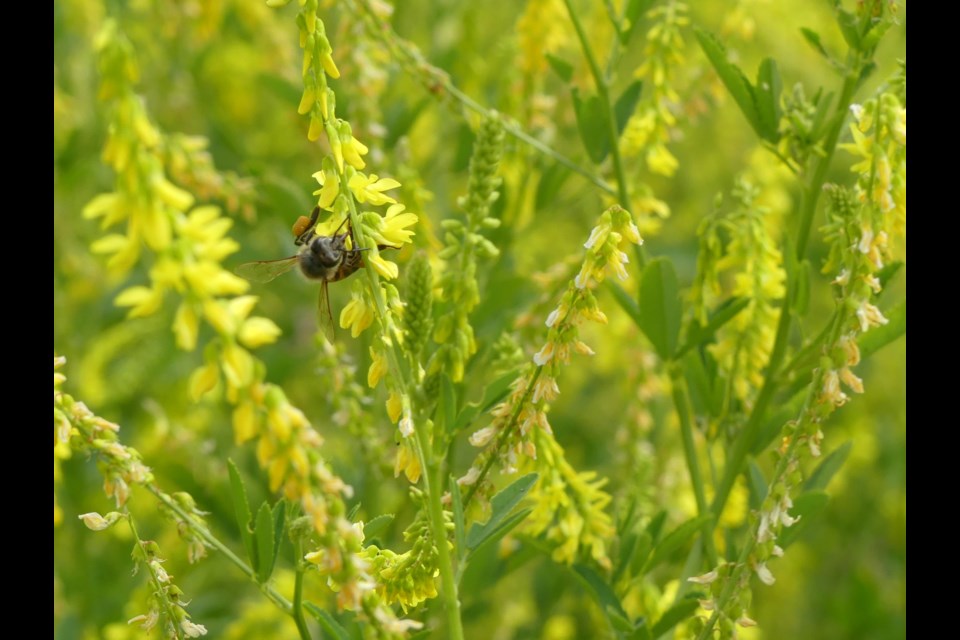While some Holland Marsh farmers have complained about the untended berms along the canal, University of Guelph researchers are studying them as potentially the perfect places to help pollinators flourish.
Their study, funded by the Ontario Ministry of Agriculture, Food and Rural Affairs, is a berm enhancement project — growing different types of plants to add to the ones already there, and then monitoring them to see whether they can attract more pollinators and natural enemy insects.
“It’s really important for the ecosystem as a whole. So when they’re passing through they have somewhere to stop and rest and eat,” said University of Guelph graduate student Dillon Muldoon.
Holland Marsh farmers could potentially benefit from the project if more natural enemies — “good pests” that eat “bad” carrot pests, for example — can increase their numbers around the marsh, he said.
The researchers are based at a Holland Marsh station in King Township, and they are using five municipality-owned locations around the marsh, four of which are in Bradford West Gwillimbury.
Each site has three 10-by-20-metre plots of land: one includes the grasses and wildflowers naturally there; one includes more recently planted flowers, such as four types of clover, butterfly milkweed and timothy; and one has flowers and shrubs, such as butterfly milkweed and haskap.
“We keep building on the types of plants that are available. We’ve kicked it up a notch above average to see if we can increase the (insect) population,” said Cynthia Scott-Dupree, a professor and Bayer chair in sustainable pest management at the University of Guelph.
She said that, while some farmers and local residents may not like the look of untended berms — strips of land bordering the canal — it is better for the environment if they are left that way.
“Mowing is not necessary. It’s an agricultural area; it’s not an urban area. Maybe have them look a little rugged and natural and there’s nothing wrong with this.”
The longer some plants are allowed to grow, the more humid the environment can get at their base, which is more attractive to some insects, she said.
Part of Muldoon’s work will also include studying the differences between areas that have taller plant life and others that are shorter, such as a berm that has been mowed.
The Holland Marsh Growers Association asked BWG council in April to fix the “checkerboard” look of the berms that are a result of some land owners mowing them and others letting them grow wild.
Its argument was the berms have become a source of weeds that invade neighbouring fields, provide habitat for vermin and other pests, and block access for irrigation purposes.
BWG council voted at that time to request a staff report on the cost of cutting the weeds within the town’s boundary, as well as any potential legal issues. The report has not yet come back to council.
The University of Guelph research project kicked off May 2017 with initial planting. By the end of this year, the team expects to have a solid year of data on how the berm enhancements have affected insect populations, Muldoon said.
It is building off research conducted several years ago, which found natural enemy insect populations are “abundant and diverse in the (Holland Marsh), despite intensive cultivation of land,” he said.
Despite the marsh’s expansive land area, it “does not provide a good habitat for beneficial
insects,” he said, and the research project is hoping to improve that.
Muldoon and fellow graduate student Alexandra Stinson are the project’s main researchers, who are in the Holland Marsh three days a week.
While Muldoon’s work is mainly in the berms, Stinson’s focus is doing in-field research trials at the research station, which involves weeding, hoeing and investigating different insecticides, she said.
Part of her work is to see what the best options are for farmers. For example, will a crop have less damage from pests if it is planted after specific pest populations peak, or with specific pesticides?
“Although pollinators are not integrally important to the production of cultivated crops in the (Holland Marsh), improvement of forage and rest areas for them … will certainly benefit surrounding habitats and pollinator conservation as a whole,” Muldoon said.
“We hope to provide an opportunity for the general public to understand that growers and stakeholders in and around the (Holland Marsh) demonstrate sustainable management programs that promote ecosystem balance and sustainability.”
The entire project will wrap up in April 2020, and the team plans to host public events to share their results with local residents and farmers.

